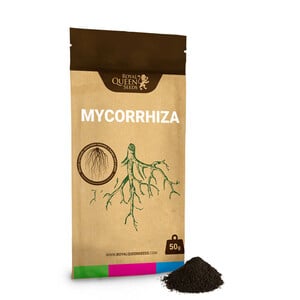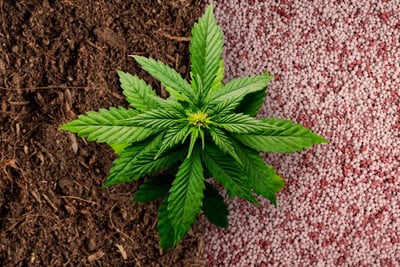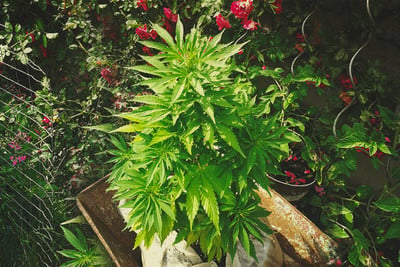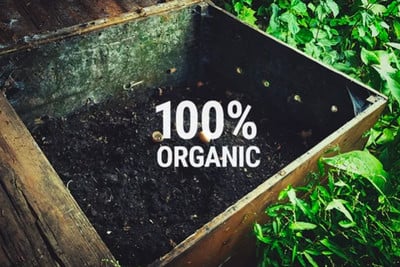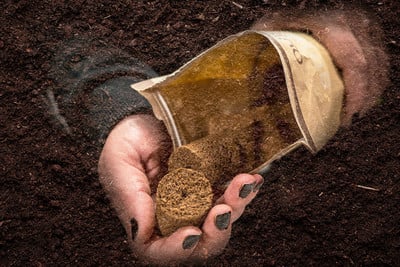.

Use Compost Tea To Nourish Your Cannabis Plants
Compost tea is rich in nutrients and beneficial microorganisms such as nematodes, protozoa, certain bacteria, and fungi. This elixir can help to defend your plants against pathogens, and may also help to enhance growth and overall health.
Learn the ins and outs of using compost tea to nourish and protect cannabis plants.
Contents:
- 1. Bacterial vs fungal compost teas
- 2. Start with good compost
- 3. Understanding the different types of compost tea
- 3.a. Aerated compost tea
- 4. Sensibilità del test antidroga
- 5. Compost tea in hydroponic and aeroponic systems
- 6. The benefits of compost tea
- 6.a. Compost tea recipe
- 7. The benefits of sprouted seed tea
- 7.a. Sprouted seed tea recipe
Compost tea is a form of brewed compost that can provide your cannabis plants with plenty of high-quality nutrients, contributing to plant health, vigour, and even defence against pathogens[1]. Despite its many beneficial effects, compost tea isn’t hard to make and requires minimal cost and effort. The main requirement for the tea is simply a bit of patience.
BACTERIAL VS FUNGAL COMPOST TEAS
When brewing compost tea, you’ll be extracting microorganisms from compost and feeding them to create a brew enriched with millions of beneficial bacterial or fungal colonies. These not only feed your plants, but can also help protect them from pathogens.
Compost teas can be either fungal or bacterial[2] depending on what ingredients you use to brew them. Bacterial teas are made with sugars (like molasses), while fungal teas use fish hydrolysate and humic acid. While the brewing process is similar for both, fungal teas tend to take longer as fungal colonies grow at slower rates.
START WITH GOOD COMPOST
The key to good compost tea, you guessed it, is good compost. Compost is the result of the slow degeneration of natural waste materials[3] such as fruit and vegetable peels, eggshells, paper, and garden trimmings.
If you’re composting at home, you’ll need a compost bin, which you can either buy online, from a garden centre, or build yourself. From there on out, you’ll want to feed your compost with a good combination of green and brown materials. For the best results, we recommend feeding your compost[4] with 25–50% green materials and 50–75% brown materials. Check the infographic above for examples of both green and brown compost ingredients.

Over time, the microorganisms in your compost bin will break down these materials into compost, a soil conditioner rich in nutrients and microscopic organisms. If you don’t have your own compost to make tea with, you can either source some from your local garden centre or make a tea with shop-bought ingredients. Some common ingredients for compost tea include:
| INGREDIENTS | BACTERIAL COMPOST TEA |
FUNGAL COMPOST TEA | BACTERIAL & FUNGAL COMPOST TEA |
|---|---|---|---|
| Fish hydrolysate | X | ||
| Kelp | X | ||
| Insect frass | X | ||
| Alfalfa | X | ||
| Glacial rock | X | ||
| Azomite | X | ||
| Bokashi | X | ||
| Humic/fulvic acid | X | ||
| Molasses | X | ||
| Yucca | X | ||
| Guano | X |
| INGREDIENTS FOR COMPOST TEA (Bacterial and Fungal) | |||||
|---|---|---|---|---|---|
| INGREDIENTS | BACTERIAL COMPOST TEA | FUNGAL COMPOST TEA | BACTERIAL & FUNGAL COMPOST TEA | ||
| Fish hydrolysate | X | ||||
| Kelp | X | ||||
| Insect frass | X | ||||
| Alfalfa | X | ||||
| Glacial rock | X | ||||
| Azomite | X | ||||
| Bokashi | X | ||||
| Humic/fulvic acid | X | ||||
| Molasses | X | ||||
| Yucca | X | ||||
| Guano | X | ||||
Remember: The ingredients you choose to use in your tea will determine whether it is fungal or bacterial.
UNDERSTANDING THE DIFFERENT TYPES OF COMPOST TEA
There are essentially six different types of compost tea[5]: aerated tea, non-aerated tea, anaerobic tea, manure tea, compost leachate, and fermented plant tea. The most common tea used by both hobby and professional cannabis growers is aerated compost tea (or ACT).
AERATED COMPOST TEA
Aerated compost teas, as the name suggests, use oxygen during the brewing process to create the perfect environment for the growth of beneficial microorganisms. If you’re brewing at home, you can make your own ACT using a 20l bucket, an air pump/air stone, and the following base ingredients:
• High-quality compost
• Worm castings
• Humus
The base ingredients of any compost tea are compost, worm castings, and humus. These ingredients are rich in microorganisms, which you’ll grow as you feed your tea. Remember, using organic ingredients produces the best quality tea and the cleanest results.
• Feed
In order to grow the bacteria and fungi in your compost, you need to feed them the right nutrients. There are many different compost tea recipes available on the internet, and we’ve included one of our favourites at the end of this article.
• Oxygen
Aerated compost teas rely on oxygen to help support the growth of beneficial bacteria and fungi. For the home grower, simply letting your ingredients brew in a bucket with an air pump should be enough. Large-scale operations with bigger budgets, on the other hand, tend to use oxygen probes for complete control over the oxygen levels in their teas.
• Temperature and time
Aerated compost teas are best brewed at temperatures between 18–30°C. Lower temperatures make it harder for microorganisms to reproduce, while hotter temperatures may promote the growth of pathogens in your tea.
Time has a similar effect on compost tea. Microorganisms take time to grow, but over-brewing creates a breeding ground for bad bacteria and fungi. To play it safe, we recommend brewing your tea for exactly 24 hours.
TOOLS FOR MEASURING THE CONDUCTIVITY OF YOUR COMPOST TEA
Rather than blindly brewing and feeding your plants with compost tea, you’ll want to measure the conductivity of your brew to get a clearer picture of its content. Use the RQS pH and conductivity testers to ensure you’re doing right by your plants.
COMPOST TEA IN HYDROPONIC AND AEROPONIC SYSTEMS
While we tend to think of using compost teas with soil-grown cannabis, they can also be used in hydro or aero setups; you’ll just need to adjust your dosage. For soil-grown plants, we recommend using roughly 120ml per litre of water. In hydro, we recommend feeding 1 litre of tea per 30l of reservoir water.
Unlike chemical fertilisers, it’s a lot harder to overfeed your plants with compost tea.

THE BENEFITS OF COMPOST TEA
Compost tea contains millions of beneficial bacteria and fungi. By applying it to your plants’ roots or spraying it on their leaves, you’ll benefit their development in numerous ways.
Some of the main benefits of compost tea include:
ENHANCES PLANT GROWTH
Compost tea can assist the cannabis grower and their plants in numerous ways. One of its main benefits, and perhaps the most important to many growers out there, is that it helps to boost plant growth—a very important factor for those cultivators looking for large and resinous buds when harvest time swings around.
The sheer volume of nutrients within compost tea massively assists in the health of plants, ensuring proper and robust development. Such a potent dose of nutrients will help prevent deficiencies from setting in, which can ultimately reduce yields and obstruct proper growth and size.
INTRODUCES BENEFICIAL MICROORGANISMS
As well as introducing nutrients into the soil, compost tea will also bring beneficial microorganisms onto the scene, which include lifeforms such as mycorrhizal fungi and predatory nematodes.
Mycorrhizal fungi can help boost the root network of cannabis plants, allowing them to extract nutrients from further afield, boosting their uptake. These fungi can also help to defend roots against microbial parasites. Predatory nematodes also act as a natural defence, feeding upon microbes that have an appetite for cannabis roots.
Compost tea will also introduce predatory nematodes into the rhizosphere of your herbal garden. These tiny, worm-like creatures help to protect plants against a variety of other microorganisms, including others types of nematodes.
When compost tea is applied as a foliar spray, the nematodes within can even attack and defend against insect pests on leaves and stems, such as leaf miners.
ELIMINATES THE NEED FOR TOXIC CHEMICALS
Using compost tea may remove the need for you to apply chemicals to your garden that are toxic to you and the environment. Compost tea is a nutritious elixir, removing the need for synthetic fertilisers that sometimes burn roots.
COMPOST TEA RECIPE
The following compost tea recipe was devised by soil microbiologist[6] and researcher Dr. Elaine Ingham of Soil Foodweb Inc.
STEP 1
First of all, measure up 95 litres (25 gallons) of water into a container. If your water supply is chlorinated, then aerate your water to remove this chemical. Add 2 teaspoons of humic acid solution directly into the water. Humic acid can be purchased or extracted from your own supply of compost.
STEP 2
Next up, scoop 1–2 tablespoons of humic acid and dilute it in 2 cups of water before adding it into the compost tea. As an alternative, use 1–2 tablespoons of fish hydrolysate. This should also be prediluted if the product states that it contains acid preservatives, in order to neutralise them.

STEP 3
Now go ahead and mix ½ cup of kelp into 5 cups of water. Once adequately mixed, add this into the compost tea for a highly nutritious punch.
STEP 4
Now it's time to add in the compost. Before doing so, conduct a final check to really make sure your supply has broken down correctly and is looking healthy and biodiverse. It should be aerobic, and therefore, should smell nice and rich, like soil from a forest. This should serve as a vessel of beneficial bacteria, fungi, and protozoa. 2.3kg (5lbs) of compost should be added.
To make sure these beneficial bacteria are inside and ready to be applied to your plants, a microscope can be used. If you own one or have access to one, asses the compost using a 1:5 dilution of compost and 400X magnification. You should be able to detect thousands of bacteria in each field view, 1 stand of fungal hyphae in each 5 fields, 1 flagellate or amoebae in each 5 to 10 fields of view, and 1 beneficial nematode per drop.
If fungi are lacking in your compost, you can add foods to enhance their growth such as 1 cup of steel cut oats, bran flour, or shrimp shells. If plants need a nitrogen boost, growers should replace humic acid with the same amount of fish hydrolysate.
THE BENEFITS OF SPROUTED SEED TEA
Much like compost tea, sprouted seed tea (SST) is a nutrient-dense, low-cost cannabis fertiliser. SST is a preparation popular among organic growers for its simplicity and effectiveness, utilising fast-growing plants such as rye, barley, or corn.
Once sprouted, these seeds contain a wealth of nutrients that stimulate root growth and fulfil key physiological functions. These include a battery of proteins, amino acids, and enzymes. Sprouted seeds also contain gibberellic acids—growth hormones involved in the growth of shoots, leaves, and flowers. SST serves as both a root drench and a foliar spray.
SPROUTED SEED TEA RECIPE
It’s not hard to see why so many growers are turning to this cheap and natural method of fertilisation. All it takes is a bag of seeds, a bit of water, and time. Learn how to make your own supply of SST below.

WHAT YOU’LL NEED
• 56 grams barley seed
• Clean water
• Large bowl
• Jar
• Sieve
• Blender
• Bucket
DIRECTIONS
STEP 1
Place your barley seeds in a large bowl and cover in water. Let them soak for eight hours.
STEP 2
Most of the seeds will be floating on the surface. Give them a gentle tap and watch them sink to the bottom. You’ll notice a layer of debris floating on top. Remove it by skimming it off or pouring it into the sink.
STEP 3
Strain your clean seeds from your water using a sieve, and transfer them into the jar for sprouting. Allow them to sprout for a total of three days, rinsing them each morning and evening. Within 24 hours, you’ll notice small white tendrils emerging from the seeds. This is where all that valuable nutrition resides. By day three, these structures will be significantly longer.
STEP 4
Place your sprouted seeds into a blender and fill halfway with water. Blend them for around 20 seconds to create a soapy white mixture.
STEP 5
Fill a bucket with 5 gallons (19l) of clean water. Strain the mixture through a sieve and into the bucket. Mix the solution well.
STEP 6
Apply the SST as a foliar spray or directly into the soil. Happy growing!
- https://theseedfactory.us/downloads/1-cannabis/4-growing-curing/Compost%20Tea%20Production.pdf","file:///C:/Users/Marta/Downloads/Th%C3%A9%20de%20compost.pdf
- https://www.epa.gov/recycle/composting-home
- https://www.nationalgeographic.com/family/article/your-guide-to-composting-with-kids
- Ingham, E.R. (2005) The Compost Tea Brewing Manual. Fifth Edition, Soil Foodweb Institute, Corvallis, 91. - References - Scientific Research Publishing https://www.scirp.org
- https://www.researchgate.net/publication/288547427_The_microbiology_of_vermicomposting


























